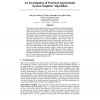Free Online Productivity Tools
i2Speak
i2Symbol
i2OCR
iTex2Img
iWeb2Print
iWeb2Shot
i2Type
iPdf2Split
iPdf2Merge
i2Bopomofo
i2Arabic
i2Style
i2Image
i2PDF
iLatex2Rtf
Sci2ools
NIPS
2004
2004
An Investigation of Practical Approximate Nearest Neighbor Algorithms
This paper concerns approximate nearest neighbor searching algorithms, which have become increasingly important, especially in high dimensional perception areas such as computer vision, with dozens of publications in recent years. Much of this enthusiasm is due to a successful new approximate nearest neighbor approach called Locality Sensitive Hashing (LSH). In this paper we ask the question: can earlier spatial data structure approaches to exact nearest neighbor, such as metric trees, be altered to provide approximate answers to proximity queries and if so, how? We introduce a new kind of metric tree that allows overlap: certain datapoints may appear in both the children of a parent. We also introduce new approximate k-NN search algorithms on this structure. We show why these structures should be able to exploit the same randomprojection-based approximations that LSH enjoys, but with a simpler algorithm and perhaps with greater efficiency. We then provide a detailed empirical evaluat...
Approximate Nearest Neighbor | Metric Tree | Neighbor Searching Algorithms | NIPS 2004 | NIPS 2007 |
| Added | 31 Oct 2010 |
| Updated | 31 Oct 2010 |
| Type | Conference |
| Year | 2004 |
| Where | NIPS |
| Authors | Ting Liu, Andrew W. Moore, Alexander G. Gray, Ke Yang |
Comments (0)

